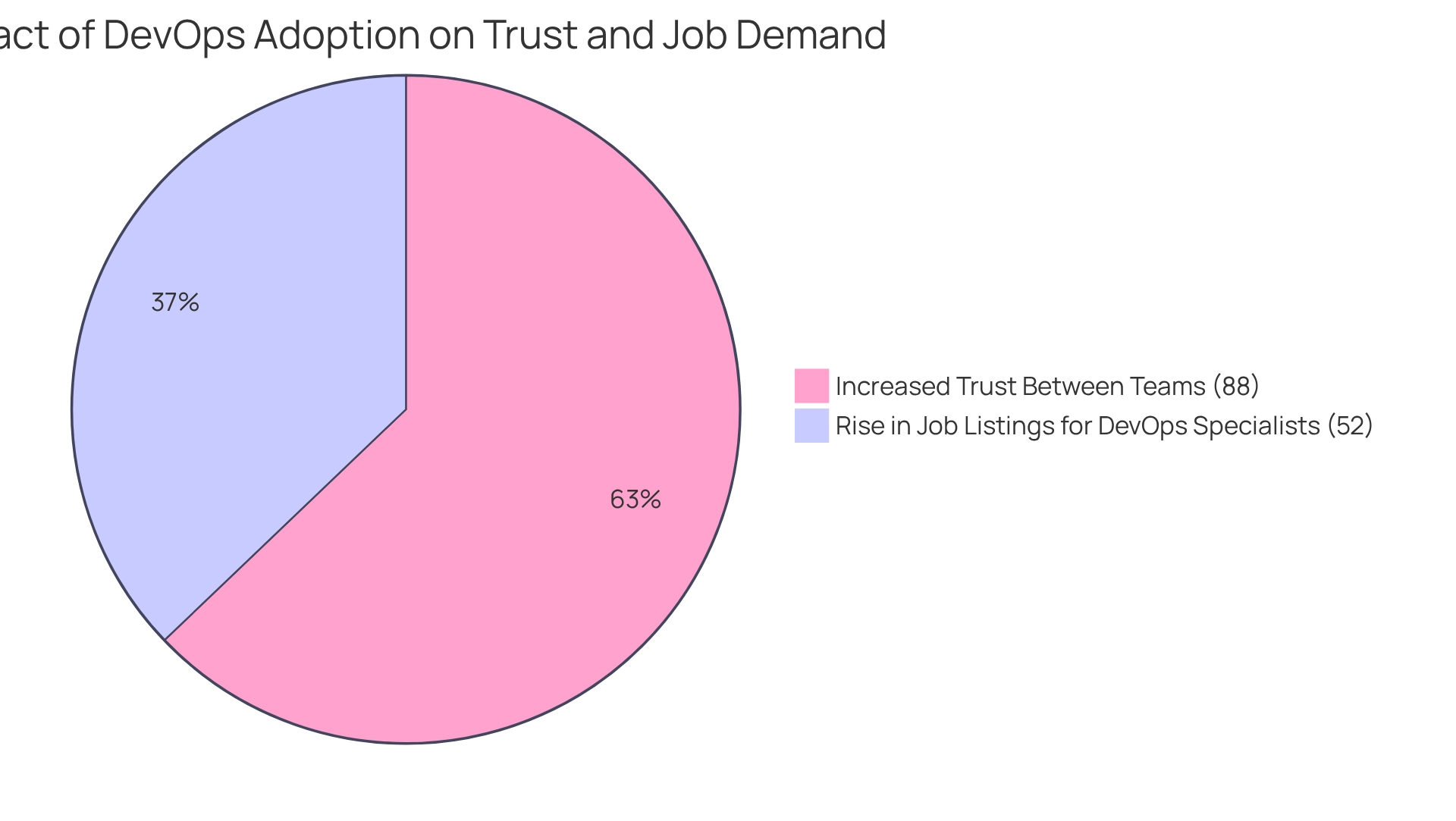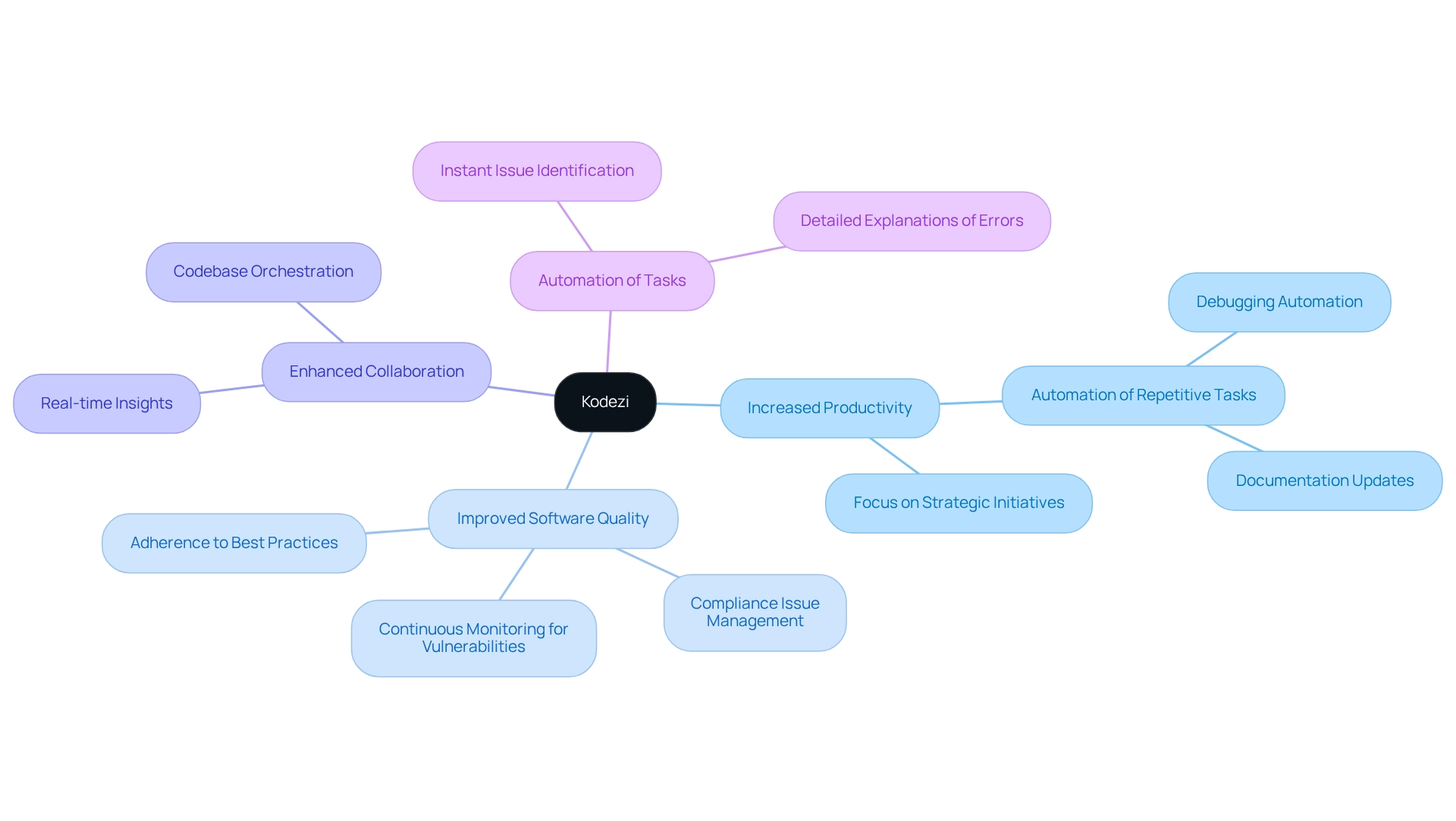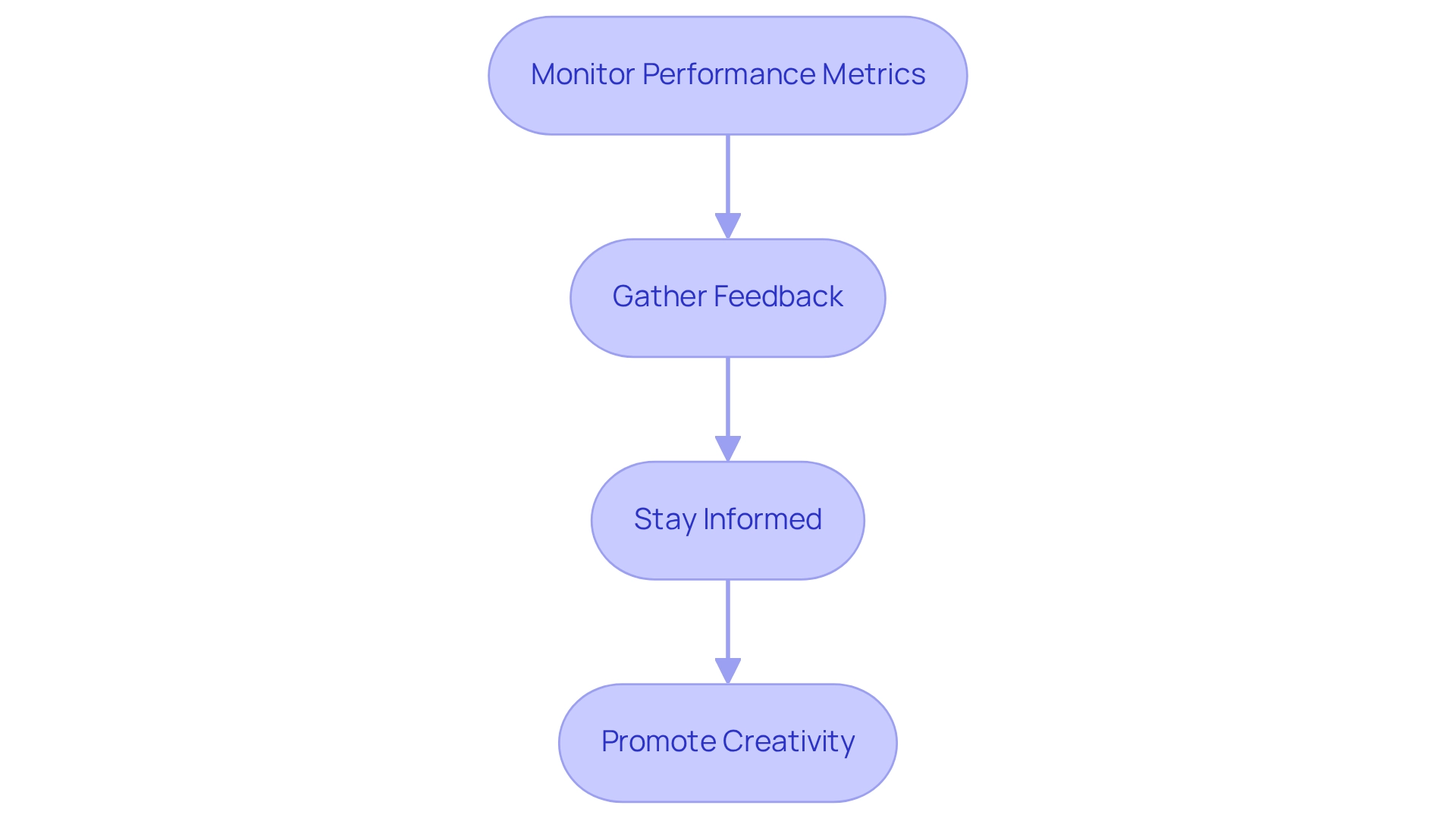Overview
Developers often face significant challenges in managing their codebases effectively. The article focuses on four key practices for effectively using a codebase orchestration tool:
- Assessing current workflows
- Selecting the right tool
- Training team members
- Starting with pilot projects
How does Kodezi address these challenges? By providing tools that streamline these practices, Kodezi enhances project efficiency and fosters team collaboration. These practices are essential as they ensure that developers can automate repetitive tasks and maintain high software quality. The result? Improved productivity and innovation within teams. Explore the tools available on the Kodezi platform to transform your coding experience.
Introduction
In the ever-evolving landscape of software development, developers face numerous coding challenges that can hinder productivity and code quality. Have you ever found yourself overwhelmed by manual debugging or struggling to maintain a clean codebase? Codebase orchestration tools, such as Kodezi CLI, are here to address these issues head-on. By revolutionizing how engineering teams automate and streamline their processes, Kodezi ensures that software remains clean and production-ready.
Kodezi continuously monitors code, identifying issues and implementing fixes autonomously. This not only alleviates the burden of manual debugging but also fosters a culture of innovation within teams. Imagine the productivity gains when your team can focus on developing new features rather than fixing bugs. As organizations increasingly embrace DevOps methodologies, understanding the benefits and best practices of these orchestration tools becomes paramount for maintaining high-quality software and operational efficiency.
In addition to automating fixes, Kodezi empowers teams to improve their coding practices. By integrating these tools into your workflow, you can enhance collaboration and streamline processes, ultimately leading to a more efficient development cycle. This article delves into the transformative power of codebase orchestration, providing insights on implementation strategies and the importance of continuous improvement in a rapidly changing technological environment. Explore how Kodezi can elevate your coding experience and drive your projects to success.
Understand Codebase Orchestration Tools
In today's fast-paced development environment, managing codebases effectively is a significant challenge for developers. A codebase orchestration tool is essential for automating and simplifying codebase management, ensuring that software remains clean, compliant, and production-ready over time. Unlike traditional tools that primarily focus on script generation, orchestration solutions like Kodezi CLI continuously monitor existing scripts, identify issues, and autonomously implement fixes. This proactive strategy not only reduces technical debt but also boosts overall productivity by maintaining code quality before any deployment.
Furthermore, Kodezi CLI integrates seamlessly with version control systems, CI/CD pipelines, and observability platforms, offering a comprehensive solution for codebase maintenance. By leveraging these resources, engineering teams can significantly alleviate the burdens of manual refactoring and debugging, allowing them to focus on innovation and development.
Recent statistics reveal that:
- 88% of companies embracing a DevOps mindset report increased trust between development and operations teams, highlighting the importance of collaboration in software maintenance.
- The growing demand for DevOps specialists, evidenced by a 52% rise in job listings, underscores the increasing recognition of effective codebase management strategies and the vital role that a codebase orchestration tool like Kodezi CLI plays in this context.
As we approach 2027, advancements in AI-driven anomaly detection are expected to prevent 90% of potential system failures. This emphasizes the critical role of automation in maintaining software quality, particularly through solutions like Kodezi CLI, which serves as a codebase orchestration tool by offering features such as bug resolution, performance optimization, security compliance, and enhancements, collectively improving the maintainability of software repositories.
In a landscape where effective communication is paramount, Sr. Technical Writer Gurpreet Kaur notes, "technology has the power to transform the world, and it is essential to make it more accessible through clear and engaging writing." This perspective is crucial for engineering teams utilizing management systems to ensure their codebases are not only functional but also understandable and sustainable.
By preventing the degradation of existing code, solutions like Kodezi CLI empower engineering teams to uphold high standards of software quality and operational efficiency. Are you ready to explore how these tools can enhance your coding practices?

Leverage Benefits of Codebase Orchestration
Developers often face significant coding challenges that can hinder productivity. How can these obstacles be overcome? Enter Kodezi, a powerful tool that automates repetitive tasks like debugging and documentation updates. This allows developers to redirect their focus towards more strategic initiatives, enhancing overall productivity.
Furthermore, Kodezi continuously monitors for vulnerabilities and compliance issues, significantly improving software quality. By ensuring adherence to best practices, it not only enhances the integrity of the code but also fosters a culture of excellence within development teams. Additionally, Kodezi acts as a codebase orchestration tool that promotes collaboration among team members by providing real-time insights and updates, which can drastically reduce the time spent on code evaluations and integration procedures. For instance, Kodezi CLI's ability to instantly identify and rectify codebase issues, while offering detailed explanations of what went wrong, exemplifies the power of automation. This capability leads to an impressive 98% uptime for all automations, streamlining the development workflow. With such features, Kodezi not only boosts productivity but also cultivates a positive workplace culture, enabling teams to concentrate on innovation rather than routine maintenance.
In conclusion, exploring the tools available on Kodezi could be a game-changer for developers looking to enhance their coding practices. Are you ready to elevate your software development experience?

Implement Codebase Orchestration Effectively
In the fast-evolving world of software development, teams often grapple with the complexities of managing their codebases effectively. Implementing a codebase orchestration tool is essential to tackle these challenges head-on. But how can teams ensure they do this successfully?
- Start by assessing current workflows. A thorough review of existing development procedures can reveal areas where coordination can enhance efficiency and reduce complexity. This step is critical, as studies show that 55% of IT projects during digital transformation exceed budget, often due to workflow inefficiencies.
- Next, choose the appropriate instrument. Selecting a codebase orchestration tool that aligns with your team’s specific needs and integrates seamlessly with your existing technology stack is vital. For instance, Kodezi CLI serves as a versatile solution for B2B engineering groups, independently enhancing code quality and resolving issues before they enter production through its 'AutoHeal' functionality. Consider exploring platforms like Kodezi that offer free trials and demo bookings to facilitate your decision-making process.
- Training your team is another crucial step. Comprehensive training sessions ensure that every team member is proficient in utilizing the resources available. This investment can lead to increased adoption rates and improved feature usage. Kodezi's AI-driven programming resource can significantly enhance coding skills by automatically correcting code and analyzing bugs, making it an invaluable asset for training.
- Starting small is advisable. Initiate the process with a pilot project to evaluate the system's capabilities and gather valuable feedback. This approach allows teams to identify potential obstacles and make necessary adjustments before a full-scale launch.
- As you iterate and scale, leverage insights gained from the pilot project to refine your implementation strategy. Gradually expand the application's usage across the organization, ensuring that each phase is informed by previous experiences.
- Be aware of common pitfalls. While utilizing management systems, teams may encounter challenges such as resistance to change or inadequate training. Proactively addressing these issues can facilitate a smoother transition.
By following these steps, teams can achieve a seamless transition to management systems, ultimately enhancing project efficiency and fostering employee satisfaction. As Niamh Lordan noted, "By adopting intelligent automation, the industry anticipates savings of $237-$813 billion, primarily due to reduced production costs and shorter timelines." This statistic underscores the potential advantages of effective management system implementation, particularly with innovative solutions like Kodezi.
Ensure Continuous Improvement and Adaptation
In the evolving landscape of software development, teams often encounter significant coding challenges. To address these issues effectively, teams should establish regular review cycles for their codebase orchestration tool management resources. This involves monitoring performance metrics, gathering feedback, staying informed about updates, and promoting creativity.
Monitoring Performance Metrics: Tracking key performance indicators (KPIs) such as software quality, deployment frequency, and incident response times is crucial for evaluating the impact of orchestration solutions. Smaller, more frequent deployments have been shown to improve customer satisfaction. Tools like Kodezi can automatically analyze bugs and optimize code, providing valuable insights into these metrics.
Gathering Feedback: Regularly requesting input from team members on the tool's usability and effectiveness is essential. As Eric Goebelbecker states, "Lead time is how long it takes your team to implement an enhancement or a bug fix," which underscores the importance of efficient processes. Kodezi’s AI-powered features can streamline feedback collection by automatically correcting code and explaining bugs, thereby reducing lead time.
Staying Informed: Keeping abreast of new features and updates from the codebase orchestration tool enables teams to leverage the latest capabilities. Kodezi consistently develops, supporting more than 30 programming languages and integrating with IDEs like Visual Studio Code, ensuring teams have access to advanced resources.
Promoting Creativity: Cultivating an environment of experimentation encourages team members to suggest innovative methods for utilizing resources to achieve enhanced results. For instance, Kodezi CLI can automatically repair codebases, allowing teams to explore new coding practices without the fear of introducing bugs. By committing to continuous improvement, teams can maximize the benefits of their codebase orchestration tool and adapt to changing project demands. Moreover, simpler code is easier to test and maintain, further supporting the case for ongoing enhancements.

Conclusion
The challenges developers face in coding are substantial, and the transformative power of codebase orchestration tools, particularly Kodezi CLI, cannot be overstated. By automating repetitive tasks, continuously monitoring code quality, and providing real-time insights, Kodezi enables engineering teams to focus on innovation rather than getting bogged down in manual debugging and refactoring. Furthermore, the proactive approach of tools like Kodezi not only mitigates technical debt but also enhances productivity, ensuring that software remains clean and production-ready.
Implementing these tools effectively requires a strategic approach. It begins with:
- A thorough assessment of current workflows
- The careful selection of the right tool that integrates seamlessly with existing systems
- Training team members and initiating a pilot project to lead to smoother transitions and greater adoption
In addition, continuous improvement is essential; teams must regularly review performance metrics, gather feedback, and stay updated on new features to fully leverage the capabilities of orchestration tools.
In summary, embracing codebase orchestration tools is a crucial step for organizations aiming to maintain high-quality software in a fast-paced development environment. By fostering a culture of innovation and collaboration, teams can enhance their coding practices and drive their projects toward greater success. Ultimately, this transformation in software development processes leads to improved outcomes and a more efficient workflow.
Frequently Asked Questions
What are codebase orchestration tools?
Codebase orchestration tools are essential for automating and simplifying codebase management, ensuring that software remains clean, compliant, and production-ready over time.
How does Kodezi CLI differ from traditional code management tools?
Unlike traditional tools that primarily focus on script generation, Kodezi CLI continuously monitors existing scripts, identifies issues, and autonomously implements fixes, reducing technical debt and maintaining code quality before deployment.
What integrations does Kodezi CLI offer?
Kodezi CLI integrates seamlessly with version control systems, CI/CD pipelines, and observability platforms, providing a comprehensive solution for codebase maintenance.
What benefits do codebase orchestration tools provide to engineering teams?
These tools alleviate the burdens of manual refactoring and debugging, allowing engineering teams to focus on innovation and development while maintaining high standards of software quality.
What is the significance of the rise in DevOps specialists?
The 52% rise in job listings for DevOps specialists highlights the increasing recognition of effective codebase management strategies and the vital role that tools like Kodezi CLI play in this context.
What advancements are expected in AI-driven anomaly detection by 2027?
It is expected that advancements in AI-driven anomaly detection will prevent 90% of potential system failures, emphasizing the critical role of automation in maintaining software quality.
What features does Kodezi CLI offer to improve software maintainability?
Kodezi CLI offers features such as bug resolution, performance optimization, security compliance, and enhancements, collectively improving the maintainability of software repositories.
Why is effective communication important in software maintenance?
Effective communication is crucial for ensuring that codebases are not only functional but also understandable and sustainable, as noted by Sr. Technical Writer Gurpreet Kaur.




